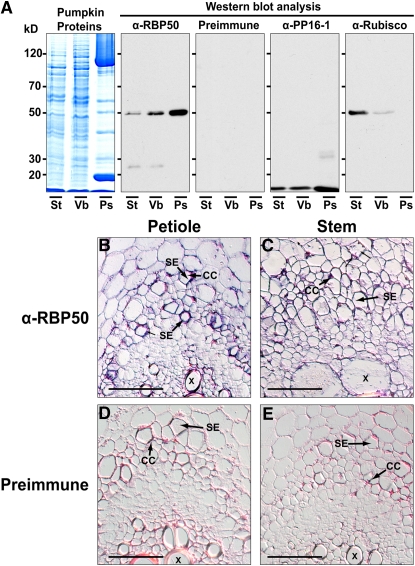Figure 4.
RBP50 Is Synthesized in Companion Cells and Accumulates in Sieve Elements.
(A) RBP50 accumulates in the phloem. Proteins extracted from pumpkin stem (St), vascular bundles (Vb), and phloem sap (Ps) were resolved on a 12% SDS-PAGE gel and visualized with GBS reagent. Proteins were transferred to nitrocellulose membranes, and blotting was performed with anti-RBP50 antibody, preimmune serum, anti-PP16-1 antibody, or anti-Rubisco antibody. Protein gel blot analysis indicated that RBP50 and PP16-1 accumulate in sieve elements. Preimmune serum failed to detect proteins extracted from these pumpkin tissues. Anti-Rubisco antibody, which served as a control against phloem sap contamination by proteins from surrounding tissue, did not detect the presence of Rubisco in the phloem sap. Results are based on three independent replicate experiments.
(B) Immunohistochemical detection of RBP50 within companion cells (CC) and sieve elements (SE) of pumpkin petiole vascular bundles. RBP50 was detected using a combination of anti-RBP50 primary antibody followed by anti-rabbit IgG as a secondary antibody.
(C) Immunohistochemical detection of RBP50 within companion cells and sieve elements of pumpkin stem vascular bundles.
(D) and (E) Immunohistochemical controls performed on petiole and stem sections with preimmune sera. Note the absence of signal within the phloem tissues.
Bars = 500 μm for (B) to (E).

